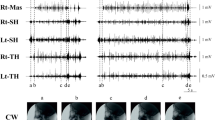Nineteen young healthy subjects were offered a morsel of hard (walnut) and soft (cake) food, while surface EMG was recorded bilaterally from the masseter muscles. The duration of the entire sequence of chewing, chewing rate, number of chewing cycles, time/cycle ratio, and mean and maximum EMG amplitudes of the above muscles were compared in women and men (n = 12 and 7, respectively). The duration of the whole chewing sequence for the soft food and duration of a single chewing cycle for both food types were significantly longer in women (P = 0.000). The masticatory frequencies for both food types were significantly greater in men (soft food: 0.98 ± 0.18 and 1.79 ± 0.18 sec–1, hard food: 1.25 ± 0.29 and 2.03 ± 0.32 sec–1 in women and men, respectively; P = 0.000). The numbers of chewing cycles for both food types were statistically similar (P = 0.38 and P = 0.67). The mean and maximum EMG amplitude were found to be nearly similar in women and men, except that the mean amplitude of the right EMG at soft food chewing was significantly higher in men (P = 0.02). Thus, chewing in women occurs, in general, more slowly, while masseter muscle activities are rather similar. The food consistency exerts a mild overall influence on the gender differences of chewing.
Similar content being viewed by others
References
S. Kiliaridis, S. Karlsson, and H. Kjellberg, “Characteristics of masticatory mandibular movements and velocity in growing individuals and young adults.” J. Dent. Res., 70, No. 10, 1367-1370 (1991).
E. G. Gisel, L. J. Lange, and C. W. Niman, “Chewing cycles in 4- and 5-year-old Down’s syndrome children: a comparison of eating efficacy with normals,” Am. J. Occup. Ther., 38, No. 10, 666-670 (1984).
R. E. Youssef, G. S. Throckmorton, E. 3rd Ellis and D. P. Sinn, “Comparison of habitual masticatory patterns in men and women using a custom computer program,” J. Prosthet. Dent., 78, No. 2, 179-186 (1997).
V. F. Ferrario and C. Sforza, “Coordinated electromyographic activity of the human masseter and temporalis anterior muscles during mastication,” Eur. J. Oral Sci., 104, Nos. 5–6, 511–517 (1996).
D. J. Neill and P. G. Howell, “A study of mastication in dentate individuals,” Int. J. Prosthodont., 1, No. 1, 93-98 (1988).
M. A. Peyron, O. Blanc, J. P. Lund, and A. Woda, “Influence of age on adaptability of human mastication,” J. Neurophysiol., 92, No. 2, 773-779 (2004).
G. Berretin-Felix, K. F. Genaro, I. E. Trindade, and A. S. Trindade Jr., “Masticatory function in temporomandibular dysfunction patients: electromyographic evaluation,” J. Appl. Oral Sci., 13, No. 4, 360-365 (2005).
A. Woda, K. Foster, A. Mishellany, and M. A. Peyron, “Adaptation of healthy mastication to factors pertaining to the individual or to the food,” Physiol. Behav., 89, No. 1, 28-35 (2006).
E. G. Gisel, “Chewing cycles in 2- to 8-year-old normal children: a developmental profile,” Am. J. Occup. Ther., 42, No. 1, 40-46 (1988).
J. M. Varela, N. B. Castro, B. M. Biedma, et al., “A comparison of the methods used to determine chewing preference,” J. Oral Rehabil., 30, No. 10, 990-994 (2003).
J. Paphangkorakit, N. Thothongkam, and N. Supanont, “Chewing-side determination of three food textures,” J. Oral Rehabil., 33 No. 1, 2-7 (2006).
P. B. James, C. M. David, and D. S. William, “Gender differences in risk taking: A meta-analysis,” Psychol. Bull., 125, No. 3, 367-383 (1999).
A. Feingold, “Gender differences in personality: a metaanalysis,” Psychol. Bull., 116, No. 3, 429-456 (1994).
A. Guyton and J. E. Hall, Textbook of Medical Physiology, Elsevier Saunders, Philadelphia (2011).
S. Calderon Pdos, E. M. Kogawa, J. R. Lauris, and P. C. Conti, “The influence of gender and bruxism on the human maximum bite force,” J. Appl. Oral Sci., 14, No. 6, 448-453 (2006).
F. Cecere, S. Ruf, and H. Pancherz, “Is quantitative electromyography reliable?,” J. Orofac. Pain, 10, No. 1, 38-47 (1996).
C. Hagberg, “Electromyography and bite force studies of muscular function and dysfunction in masticatory muscles,” Swed. Dent. J. Suppl., 37, 1-64 (1986).
C. Hagberg, “The amplitude distribution of electromyographic activity of masticatory muscles during unilateral chewing,” J. Oral Rehabil., 13, No. 6, 567-574 (1986).
C. Hagberg, “The amplitude distribution of electromyographic activity in painful masseter muscles during unilateral chewing,” J. Oral Rehabil, 14, No. 6, 531-540 (1987).
L. V. Christensen and J. T. Radue, “Lateral preference in mastication: an electromyographic study,” J. Oral Rehabil., 12, No. 5, 429-434 (1985).
M. Saifuddin, K. Miyamoto, H. M. Ueda, et al., “A quantitative electromyographic analysis of masticatory muscle activity in usual daily life,” Oral Dis., 7, No. 2, 94-100 (2001).
M. J. Hoogmartens and M. A. Caubergh, “Chewing side preference in man correlated with handedness, footedness, eyedness and earedness,” Electromyogr. Clin. Neurophysiol., 27, No. 5, 293-300 (1987).
H. P. Delport, A. de Laat, J. Nijs, and M. J. Hoogmartens, “Preference pattern of mastication during the first chewing cycle,” Electromyogr. Clin. Neurophysiol., 23, No. 6, 491-500 (1983).
D. Giannitrapani, “Laterality preference, electrophysiology and the brain,” Electromyogr. Clin. Neurophysiol., 19, No. 1-2, 105-123 (1979).
Author information
Authors and Affiliations
Corresponding author
Rights and permissions
About this article
Cite this article
Khamnei, S., Zamanlu, M., Shakouri, S.K. et al. Mastication Patterns in Humans: Gender Differences. Neurophysiology 48, 375–379 (2016). https://doi.org/10.1007/s11062-017-9612-3
Received:
Published:
Issue Date:
DOI: https://doi.org/10.1007/s11062-017-9612-3




